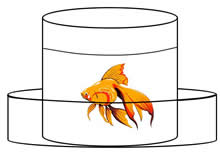Investigation: How Does Temperature Affect Respiration Rates of Fish?

Introduction: In this lab you will slowly change the water temperature of a fish and determine how changing the temperature affects the fish's respiration rate. Recall that HOMEOSTASIS refers to an organism's ability to respond to environmental changes and maintain its own internal balance.
Prediction: How do you think the temperature affects breath rate? As the temperature decreases, the respiration rate will:
increase, decrease, or stay the same (circle)
Procedure:
Step 1. Record the temperature of your fish’s water on the data table. 
Step 2. Count the number of breaths the fish takes at this temperature over 30 seconds and record on the data table. 
Step 3. Use an empty bowl and add cold, icy water. Place the fish beaker in the ice bath. 
Step 4. Watch as the temperature slowly changes. When it reaches each of the ranges in the data table, write down the exact temperature in the data table and record the number of breaths the fish takes. 
Step 5. While you are waiting for temperature changes, answer the questions below: 
Step 6: Compare your data to the group sitting nearby and fill out the table for Fish 2.
What Do You Know About Fish?
1. The structure that covers the gills is the [ lateral line / operculum / caudal ]
2. The main structure for fish respiration is the [ gills / kidney / liver ]
3. Blood passes over the gills, becomes oxygenated and then travels where? [ body / heart ]
4. What kind of fish is a goldfish? [ bony / cartilage / jawless ]
5. The lateral line system of a fish is used to [ filter water / detect vibrations ]
6. An organism’s ability to respond to changes in the environment is called [ mitosis / homeostasis ]
7. An organism whose temperature changes with its surroundings is called an [ endotherm / ectotherm ]
Data Table
| Your Fish | Fish 2 | |||
| Temperature Range | Actual Temperature (thermometer reading) |
Breaths per 30 seconds | Actual Temperature (thermometer reading) |
Breaths per 30 seconds |
| 20 – 24 ° C (room) | ||||
| 16 - 19 ° C | ||||
| 12 - 15 ° C | ||||
| 11 ° C or below | ||||
***On the next page, graph your fish and fish 2 as LINES***
**Make sure that you LABEL the Y axis and the lines**
Fish Respiration Rate and Water Temperature
Analysis
1. Describe how the fish's respiration rate changes with the temperature. This should be a complete sentence that accurately describes what your data (and the graph show.)
2. Why was it important to place your fish in a water bath instead of changing the water temperature directly?
3. Goldfish can adjust to dropping temperatures much easier than they can to warming temperatures. Make a prediction based on your data about what would happen if you INCREASED the temperature of the water. Support your prediction with evidence from the lab.
4. Indicate on the graph which line would represent the endothermic animal and which line would represent the ectothermic animal. Explain how you know this.

Extension Questions
5. Design an experiment that will test how a fish's respiration rate is affected by light. Explain your design. You may wish to draw a picture of your set-up. Include how you will change the environment and what you will be measuring.

6. Metabolism refers to the chemical and physical processes required by organisms to maintain life. Ectothermic animals like fish and reptiles depend on external heat to raise their body temperatures. Explain why a lizard will bask in the sun after eating a large meal

